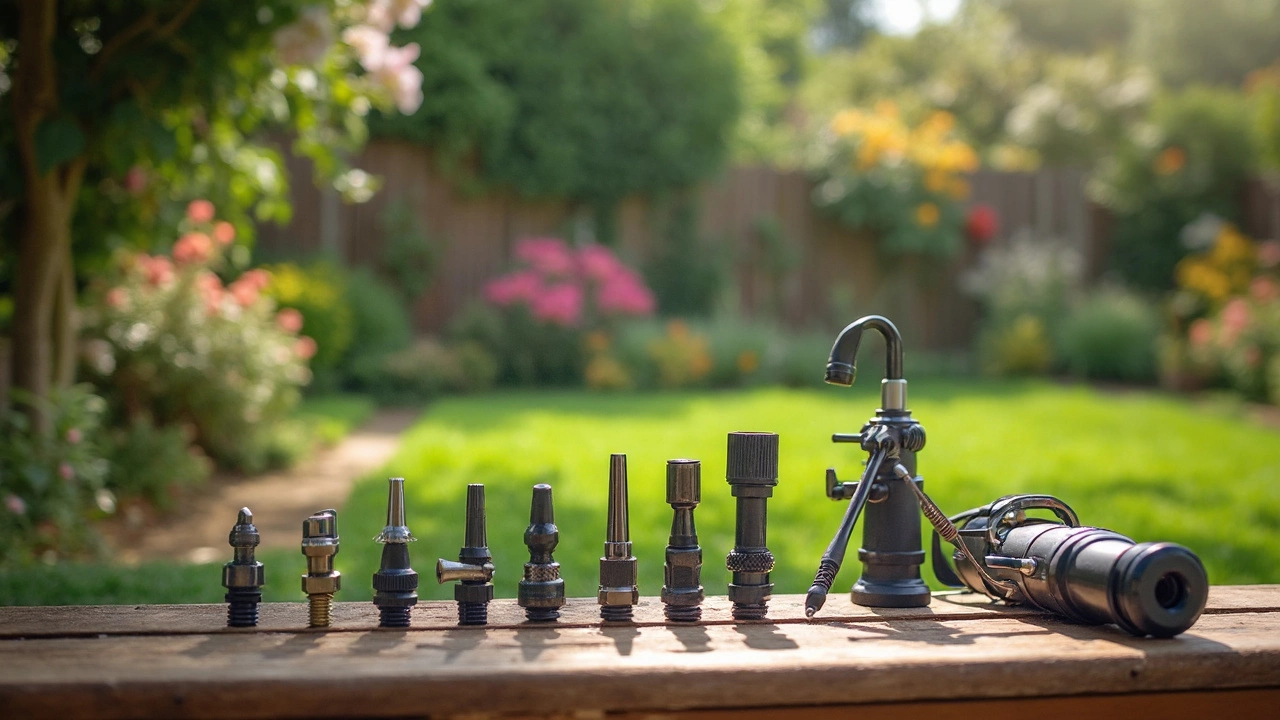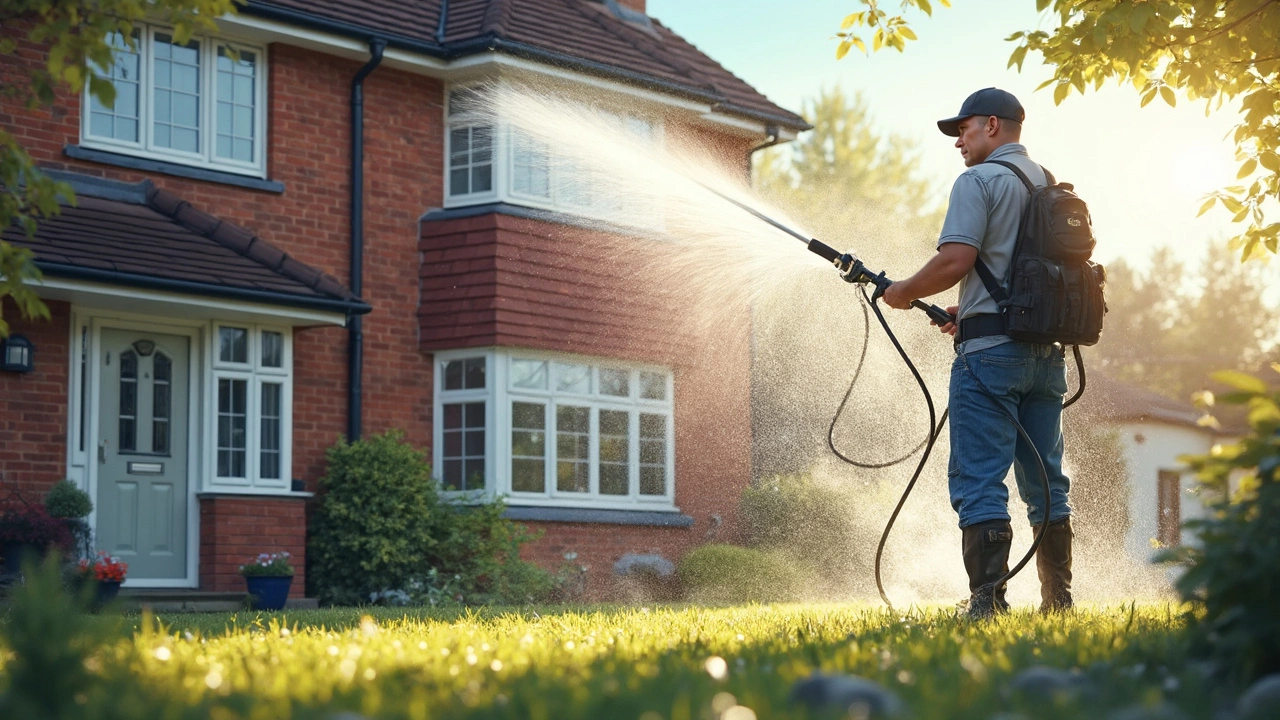Ever watch a professional pressure washer in action and wonder how they make it seem so effortless? The secret lies in their choice of tools and techniques. It’s not just about hosing things down with any old machine. Professionals opt for commercial-grade pressure washers, and there's a good reason for it. These machines pack a punch with their high PSI (pounds per square inch) and GPM (gallons per minute), which translates into more efficient and effective cleaning.
But it’s not just about raw power. Choosing the right nozzle can seriously change the game. Imagine mistaking a gentle shower for a high-powered blast—it's all in the nozzle's setting. Professionals know which angle and spray pattern work best for different surfaces, ensuring there's no damage to the paint or structures.
And let's not forget detergents. They aren't just for cutting grease or cleaning scuff marks. The right detergent can break down dirt and grime, making the wash more effective and sometimes even reducing the need for higher pressure, which can protect delicate surfaces like wood siding.
- The Power of Commercial Grade Pressure Washers
- Why Nozzles Matter More Than You Think
- The Role of Detergents in Pressure Washing
- Safety Gear Every Pro Uses
- Pre-Wash Prep: Setting the Stage for Success
- Maintaining Your Pressure Washing Equipment
The Power of Commercial Grade Pressure Washers
When it comes to getting a house spick and span, professionals don't mess around with the weak stuff. They've got commercial grade pressure washers in their arsenal. These big league machines are designed to handle serious dirt and grime with impressive force. We're talking about equipment that can hit over 3,000 PSI and deliver around 4 GPM. That's some serious cleaning power right there.
So, why do pros opt for high-pressure machines instead of your average Joe washer? It's simple. The more pressure and water flow you have, the faster and more thorough the cleaning job gets done. These heavy-duty washers can tackle everything from stubborn mold and mildew to caked-on mud and dust. Plus, they can handle larger surfaces in less time, which is crucial when you're dealing with business operations.
Another reason pros use these machines is durability. These washers are built to withstand constant use and tough conditions, unlike consumer models that might throw in the towel after a few heavy-duty sessions. They come packed with features like triplex pumps and heavy-duty brass components that ensure longevity and reliable performance.
Here’s a quick look at the difference between some basic specs:
| Feature | Commercial Grade Washer | Consumer Washer |
|---|---|---|
| PSI (Pounds per Square Inch) | 3,000 - 4,500 | 2,000 - 3,000 |
| GPM (Gallons per Minute) | 3.5 - 4 | 1.2 - 2.0 |
| Pump Type | Triplex | Axial or wobble |
For someone looking to take their home cleaning game to a professional level, investing in a commercial-grade washer might just be worth it. You'll not only cut down on the time spent scrubbing but also ensure that every nook and cranny is spotless.
Why Nozzles Matter More Than You Think
So, you might think a pressure washer is a one-size-fits-all deal, but the nozzle is where the magic really happens. Choosing the right nozzle can prevent you from turning your home's exterior into a disaster zone. It's like switching from a firehose to a garden sprinkler just by changing a tiny piece of equipment.
Nozzles come in various angles, usually marked in degrees: 0, 15, 25, 40, and so on. Each one suits different kinds of cleaning jobs. A 0-degree nozzle is like a laser-focused stream and can actually peel paint or damage wood if you're not careful. The 25-degree nozzle is more forgiving—perfect for washing down siding or driveways without the risk of unwanted stripping.
According to Alex Jenkins, a well-respected figure in the pressure washing industry:
"Think of nozzles as the pressure washer's brain. It's not just about force, it's about precision."Wise words, right?
Professionals also often have quick-connect tips in their arsenal to make swapping nozzles a breeze. This way, they can effortlessly switch up their approach based on the surface they’re working with. If they're moving from concrete to wood or vinyl, a quick nozzle change makes sure they're applying the right pressure and spray pattern.
Here's a quick rundown of typical nozzle uses:
- 0-degree: Unblock drains or remove stubborn stains.
- 15-degree: Clean concrete or tough metal surfaces.
- 25-degree: Wash cars, boats, and fragile siding.
- 40-degree: Gentle rinse for windows and blinds.
Getting the right nozzle isn't just about cleaner surfaces; it's also crucial for safety, preventing gouging or damage. Investing a bit of time in understanding nozzles can transform a good clean into a great one.
The Role of Detergents in Pressure Washing
You might think that pressure washing is all about, well, pressure, but adding the right detergent can be a game changer. Why, you ask? Because detergents are like those secret ingredients in cooking that elevate a dish from good to amazing. They help break down dirt and grime more effectively, making the entire cleaning process smoother and less time-consuming.
Here's a cool fact: using detergents can often mean less pressure is needed, which helps protect surfaces like wood and siding from damage. This is super important because too much pressure can actually harm what you're trying to clean.
When choosing a detergent for your house cleaning, look at what you're dealing with. Mildew? Go for a detergent with fungicidal properties. Grease or oil stains? A degreaser in your mix will work wonders. And always check if it's safe for your specific pressure washer.
- Pick the Right Detergent: Make sure it's suitable for the surface you're cleaning. Concrete, for example, might need something stronger than a gentle vinyl siding cleaner.
- Pre-wash Treatment: Apply detergent using the pressure washer's low-pressure setting, giving you better coverage without splattering everywhere.
- Allow Time to Work: Don’t rinse too soon. Give the detergent some time to break down dirt—usually about 5-10 minutes.
- Rinse Off Thoroughly: Use a high-pressure rinse to make sure you remove all detergent. Leftover soap can leave streaks or damage surfaces over time.
The right detergent, when paired with a professional pressure washer, can make cleaning faster and more effective. It’s about working smarter, not harder, and getting that home exterior looking top-notch without unnecessary hassle.

Safety Gear Every Pro Uses
When it comes to pressure washing, safety shouldn't take a back seat. Professionals know that using the right gear not only keeps them safe but also makes their work more efficient. Let's break down the essentials you might spot on a pro, starting with protective eyewear.
High-powered machines can send debris flying, so a sturdy pair of safety goggles is a must. They guard those precious peepers from unexpected splashes and flying particles. Trust me, you don't want a rogue piece of dirt finding its way into your eye.
Next up, let's talk about hearing protection. With some machines sounding like a jet engine at close quarters, ear protection isn't just a 'nice-to-have'—it's essential. Noise-canceling earmuffs or earplugs do the trick in preventing long-term hearing damage.
Then we've got gloves, and not just any old pair. Waterproof, non-slip gloves help maintain a firm grip on the equipment, which is crucial when dealing with high-pressure streams. They also shield your hands from harsh detergents, which can be as unfriendly to skin as they are to dirt.
A sturdy pair of boots is another staple in a pro's kit. Ideally, these are steel-toed with a non-slip sole to prevent any unfortunate slips or stubbed toes. Remember, walking on wet surfaces can get tricky, so decent footwear keeps you steady.
And finally, don't underestimate the power of a good old coverall or waterproof suit. These are lifesavers against water and cleaner splashes, leaving you dry to work comfortably. They’re like a second skin for the pros—armor against the elements!
Here's a quick look at what a professional's gear list might look like:
- Safety goggles
- Ear protection
- Waterproof, non-slip gloves
- Steel-toed, non-slip boots
- Waterproof coveralls or suits
Whether you're a seasoned pro or just tackling your own house, safety never goes out of style. Suited up, you're not just protecting yourself, you're ensuring that your clean-up operation goes off without a hitch.
Pre-Wash Prep: Setting the Stage for Success
Before you even think about firing up that powerful pressure washer, there’s some crucial groundwork to lay. Prep work might sound boring, but believe me, it can make all the difference. Missing this step can lead to a job that's way less effective or even damaging to your house.
First things first, take a good look at the areas you’re planning to wash. Inspect for any cracks, peeling paint, or other damaged spots that need fixing. Pressure washing these areas can make them worse, so it’s better to get them sorted out beforehand.
Next, clear away any obstacles. Move outdoor furniture, potted plants, and light fixtures out of the way. Not only does this let you reach more spots, but it also keeps your stuff safe from high-pressure cleaning. Oh, and don’t forget to close windows and doors tightly. Trust me, you don’t want water sneaking inside.
Now, cover up the essentials. Use plastic sheets or tarps to protect electrical outlets, vents, and any delicate surfaces. Doing this keeps water out of places it shouldn’t go, saving you from potential damage or electrical hazards.
Lastly, don't overlook the value of pre-wetting the house. Spraying surfaces with low pressure helps to soften up the dirt, making it easier to blast away when you kick things up a notch. Plus, it's a great way to prevent detergent from sticking too much to the surface, which can cause streaking.
It might feel like extra work, but this preparation makes your washing run smoothly. It's these little details that separate a pro job from an amateur one and ensure your house gets the sparkling clean it deserves.
Maintaining Your Pressure Washing Equipment
Keeping your pressure washing gear in top shape isn’t just for the pros. If you want your equipment to last and perform efficiently, regular maintenance is key. It's like taking care of a car—ignore it, and you might end up with a costly repair or replacement down the road.
First, always start by giving your machine a thorough check-over after each use. This might seem tedious, but spotting any issues early on can save you a headache later. Inspect the hoses and connections for any signs of wear or leaks. If anything seems amiss, it’s usually better to replace those parts sooner rather than later.
Oil changes aren't just for cars; your pressure washer's pump oil needs regular changing too. Generally, replacing it after every 50 hours of use is a good rule of thumb. This helps in keeping the internal components running smoothly and prevents any nasty build-up.
Another vital part of maintenance is taking care of the nozzles. Clogged or damaged nozzles can reduce water pressure and affect cleaning performance. Routinely soak them in a vinegar-water solution to clear any mineral deposits, and inspect them for signs of damage.
When it comes to storage, don’t just shove your equipment in the garage and forget about it. Drain water from the pump and hoses to prevent freezing and cracking, especially in colder months. Keeping your machine in a dry, sheltered place also goes a long way in extending its life.
- Inspect hoses and connections regularly.
- Change pump oil every 50 hours of use.
- Clean nozzles regularly to maintain optimal performance.
- Store equipment properly to avoid damage.
A little bit of maintenance after each use means your pressure washing gear will stick around for many seasons, making cleaning up your house a breeze year after year.
